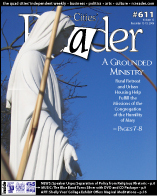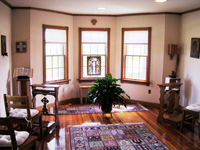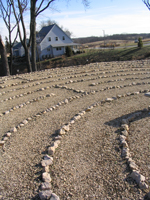 Near
Wheatland, Iowa, sits the 200-acre Our Lady of the Prairie Retreat.
It's roughly a 40-minute drive from the Quad Cities, and in one
approach a car will go from a four-lane highway to a two-lane road to
a dirt drive.
Near
Wheatland, Iowa, sits the 200-acre Our Lady of the Prairie Retreat.
It's roughly a 40-minute drive from the Quad Cities, and in one
approach a car will go from a four-lane highway to a two-lane road to
a dirt drive.
It's nearly a journey to the past, from the zipping traffic of modern times to a more primitive period, including an old farmhouse.
"Even the approach is a bit of calming, slowing down," said Sister Catherine Real, a retired member of the Davenport-based Congregation of the Humility of Mary (CHM) who volunteers as co-director of Our Lady of the Prairie. The retreat, she said, offers "a sense of God's presence" just a short drive from the urban grind.
The 200-acre site includes the original farmhouse along with a conference center (called "Prairie Heights") finished in 2003; a labyrinth for reflection; a wildlife pond; and 100 acres of prairie grasses. Its hills are reminiscent, Real said, of "Grant Wood - some of this paintings of the countryside."
The retreat first opened in 1998 and is available to any organization or person that wants to use it; affiliation with the Catholic church (or any religion, for that matter) is not required. The fees are ridiculously reasonable - five dollars per person (up to a maximum of $50) for day use of the facilities, and $25 per overnight guest.
It's not usual for a religious order to have a retreat. What is unusual about the Our Lady of the Prairie Retreat is its rural setting. While other retreat centers can handle large groups, "ours is more of a place of quiet," said Sister Joann Kuebrich, the retreat's other volunteer director. "We really emphasize the quiet." Our Lady of the Prairie can accommodate daytime groups up to 30 people and has room for 10 overnight visitors.
 That
pastoral modesty is a good fit for CHM, with its guiding principle of
care of the earth. "It's just a different part of our ministry,"
Real said. The organization's Web site notes that the word
"humility" comes from the Latin "humus," which means the
earth.
That
pastoral modesty is a good fit for CHM, with its guiding principle of
care of the earth. "It's just a different part of our ministry,"
Real said. The organization's Web site notes that the word
"humility" comes from the Latin "humus," which means the
earth.
The CHM ministry also includes Humility of Mary Housing, Incorporated, which for the past 16 years has provided affordable housing for single parents.
Both initiatives are separate corporate entities from CHM, but both also include volunteers, staff, and/or board members from the order. Six members of the 14-member Humility of Mary Housing board, for instance, come from CHM.
These two initiatives represent a ministry that is simultaneously tuned in to the needs of the urban center and the planet.
The Congregation of the Humility of Mary was founded in southeastern Iowa in the late 19th Century, an offshoot of an order that settled in Pennsylvania after fleeing religious persecution in France. Among its many activities, CHM founded Marycrest College in Davenport. (For more information on the history of CHM, visit http://www.chmiowa.org/heritage.cfm.)
Because of the principle of self-determination (part of the reforms instituted by the Second Ecumenical Council of the Vatican in the 1960s), the current ministries of CHM are too numerous to mention. Each sister is empowered to decide how best to serve God. Sister Real, for instance, was president of Sienna Heights University in Michigan, and for seven years in Cedar Rapids she directed a transitional-housing program. She returned to the Quad Cities three years ago to retire.
Core members of CHM are spread around the country, but more than half live in Davenport, and more than half are retired or semi-retired sisters. They typically volunteer in the community in retirement, although Real noted that her work at the retreat is "sometimes ... even more than full-time."
The concentration of older members at the home base of Davenport is a reflection of a nationwide trend: Few people are entering religious service. Furthermore, those that are entering the sisterhood are tending to favor more conservative orders; CHM is one of the more progressive orders, and was one of the first to embrace the principle of self-determination. Women entering the sisterhood today generally favor orders that require members to wear habits, and CHM doesn't.
The retreat and the housing program therefore represent a legacy for CHM, one that won't likely be expanded. The order presently has 146 sisters, said archivist Sister Joan Sheil. At its peak in the early 1960s, Sheil said, the order had between 300 and 400 members. CHM presently has one woman in formation and has added three or four members over the past seven or eight years, she said.
She described CHM as "an aging community that's not likely to grow younger."
Sheil said that the demographic trend isn't a concern for CHM. "It's a reality," she said.
"The Place Itself Would Speak to People"
The retreat has its roots in the closure of Ottumwa Heights College, which was founded and run by CHM. The college's operations were joined with Indian Hills Community College in 1979, but the community college didn't take over the philosophy and religion curricula, Kuebrich said.
 That,
in turn, led to an interest in continuing adult religious education,
and the formation of New Horizons of Faith by Kuebrich and Father
Vincent Fabula, a Trappist monk. One recurring theme in surveys of
educational needs was a desire for a retreat center, Kuebrich said.
That,
in turn, led to an interest in continuing adult religious education,
and the formation of New Horizons of Faith by Kuebrich and Father
Vincent Fabula, a Trappist monk. One recurring theme in surveys of
educational needs was a desire for a retreat center, Kuebrich said.
For five years, she said, she and Fabula looked at dozens of farms. They had several goals in mind: proximity to urban centers, accessibility, and that "the place itself would speak to people," Kuebrich said. Furthermore, Fabula wanted a site with tillable land that would be eligible for the federal Conservation Reserve Program (CRP). "He ... knew that retreat centers do not pay for themselves," Kuebrich said, and the extra income could help support a center.
Fabula purchased the land near Wheatland in about 1990, Kuebrich said, and spent several years preparing it - renovating the farmhouse (now called "Victorian House"), building the pond, and planting the prairie grasses for the CRP. The house, Real said, was in poor condition. "They stripped it inside and out," she said. Father Fabula was "very good with his hands."
He died in 1998 from brain cancer, just a few months after Our Lady of the Prairie Retreat opened. "He never lived to see it used as a retreat," Real said.
The Trappists explored the possibility of running the retreat themselves but didn't have the resources to do it, Kuebrich said. That's when CHM stepped in.
Our Lady of the Prairie Retreat brought in roughly 60 groups this year and averages about 800 visitors annually.
In addition to hosting groups, the retreat also offers its own programs. (The next - "The Psalms: 3,000-Year-Old Prayer" - is scheduled for February 24.)
The retreat is gorgeous, even with freezing temperatures blanching the land. Our Lady of the Prairie encourages a wide variety of contemplative activities: walking a path cut through the prairie grasses down to the wildlife pond, for example, or using the stone-and-dirt labyrinth to think, relax, or meditate.
Real explained that the labyrinth works well in part because it's unpredictable and somewhat deceptive. Walking on the prescribed path, one approaches the center but is then led back to the outside of the circular maze. Many people emerge from the labyrinth with a problem solved, or at peace.
Spiritual reflection is the goal of Our Lady of the Prairie Retreat, but CHM has also gone down a different path with its ministry - helping the poor. Instead of handing out food or offering temporary shelter - noble activities, certainly - CHM tries to help the homeless work toward self-sufficiency.
From Homeless to Self-Sufficient
 Like
the retreat center, CHM's entrance into affordable housing came
from a survey. CHM spent three years in the late 1980s exploring
unmet needs in the community and settled on affordable housing, said
Sister Mary Ann Vogel, finance director of Humility of Mary Housing.
There was a lack of affordable housing for the elderly and single
parents, and the sisters were advised, "If you want a real
challenge, go with single parents." So CHM began establishing
housing services for homeless single people and their children.
Like
the retreat center, CHM's entrance into affordable housing came
from a survey. CHM spent three years in the late 1980s exploring
unmet needs in the community and settled on affordable housing, said
Sister Mary Ann Vogel, finance director of Humility of Mary Housing.
There was a lack of affordable housing for the elderly and single
parents, and the sisters were advised, "If you want a real
challenge, go with single parents." So CHM began establishing
housing services for homeless single people and their children.
The goal was always to provide more than just a roof. "We did not want to be landlords," Vogel said.
Humility of Mary Housing is part of the "continuum of care" of social-service agencies in the Quad Cities. Together the agencies coordinate which organization is serving which constituencies to avoid the duplication of services.
Through 16 years, Humility of Mary Housing has provided housing to 558 families, including 1,090 children, Vogel said.
Humility of Mary Housing now has 49 apartments, with two of those reserved for live-in site managers, at 16 different locations. Participants get a furnished apartment with a sliding scale for rent and can be in the program for up to two years. Residents are required to meet weekly with professional social workers.
The goals for the program are not limited to the immediate aim of providing decent, affordable housing. Humility of Mary Housing also sets targets for a transition to permanent housing at departure (which was true for 89 percent of families leaving in the 2005-6 program year), increases in education or job training at high schools, colleges, or other training facilities (83 percent), and improved living skills. According to the organization's annual report, 36 percent of participants increased their earned income in 2005-6.
Although the program is demonstrably successful, it faces funding challenges. Humility of Mary Housing has an annual budget of roughly $700,000, and it has waiting lists for all its apartment types. "We still are getting 350, 400 applications a year," Vogel said.
 And
the organization closed one site this year, reducing its capacity by
six housing units. "It's the first time we ever downsized,"
said Sandra Walters, the director of the organization and a
layperson.
And
the organization closed one site this year, reducing its capacity by
six housing units. "It's the first time we ever downsized,"
said Sandra Walters, the director of the organization and a
layperson.
The problem, Vogel said, is that minimum-wage jobs don't pay enough for a single parent to rent even an apartment deemed "affordable." And the waiting list for local Section 8 housing is four years long, she said.
Humility of Mary Housing started in 1990 with a four-unit building, Walters said. In those days, the organization had a waiting list of 10 to 12 families. As people were forced off welfare in the late 1990s, she said, the demand increased.
At this point, Humility of Mary Housing's five-year strategic plan doesn't include increasing capacity. "We can get properties," Walters said, "but we can't get operations money. There aren't any more grants we can apply for."
While money is often available for construction or acquisition, many donors don't like their money to be used for operations. "People like to see where their money went," Walters said.
For more information on the Congregation of the Humility of Mary, visit (http://www.chmiowa.org).










